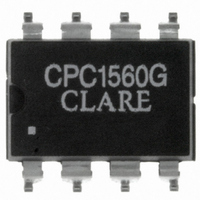CPC1560GSTR Clare, CPC1560GSTR Datasheet - Page 10

CPC1560GSTR
Manufacturer Part Number
CPC1560GSTR
Description
RELAY OPTOMOS SP-NO 600MA 8-SMD
Manufacturer
Clare
Series
CPC, OptoMOS®r
Datasheet
1.CPC1560GSTR.pdf
(14 pages)
Specifications of CPC1560GSTR
Circuit
SPST-NO (1 Form A)
Output Type
AC, DC
On-state Resistance
5.6 Ohm
Load Current
600mA
Voltage - Input
1.22VDC
Voltage - Load
0 ~ 60 V
Mounting Type
Surface Mount
Termination Style
Gull Wing
Package / Case
8-SMD (300 mil)
Lead Free Status / RoHS Status
Lead free / RoHS Compliant
Other names
CLA305TR
Available stocks
Company
Part Number
Manufacturer
Quantity
Price
Company:
Part Number:
CPC1560GSTR
Manufacturer:
CIRRUS
Quantity:
1 439
CPC1560
(C
recommended operating conditions given in this
datasheet, are constrained by the 85°C operation of
most industrial applications. For lower operating
temperature ranges, these values can be de-rated
using the information provided in the temperature
graphs in this datasheet.
One of the most important factors is the temperature
variation of the environment. From the Maximum
Allowed Energy Dissipation During t
(AC and DC) in this datasheet, the user can see how
the energy dissipated in the part during t
increases with increasing ambient temperature.
The operating frequency of the device is directly
related to the amount of energy dissipated in it during
the transition times, t
rapidly with temperature, as seen in the previously
mentioned graphs. Depending on the operating
temperature range of the application, the user must
derate the maximum allowed energy in the part during
t
provided) in order to limit the operating switching
frequency.
5.3 Current Limit and Thermal Shutdown
The CPC1560 has a current limit feature in which
current through the output switches is limited to a
value larger than the recommended operating current.
In the AC/DC configuration, the CPC1560 has
bidirectional current limiting, which consists of current
limit circuits in both positive and negative polarities. In
the DC-only configuration, the DC current limit
consists of the parallel of the two AC current limit
circuits in the positive DC polarity.
The current limit function has a negative temperature
coefficient in which increasing temperature lowers the
current limit threshold of the device. Prolonged periods
of current limiting will cause the temperature of the
device to increase, and, if allowed to continue, will
activate the device’s thermal shutdown circuitry,
forcing the output switches to turn off.
The purpose of the thermal shutdown feature is to
completely shut down the operation of the device
when its junction temperature has gone above 130°C,
whether this is due to high power dissipation in the
device in the form of heat or an increase in the
ambient temperature.
10
RISE
LOAD
5.2.1 Effects of Ambient Temperature
5.3.1 Current Limit
5.3.2 Thermal Shutdown
and t
) and load Inductance (L
FALL
(according to the temperature graphs
RISE
and t
FALL
LOAD
, which increases
), along with other
RISE
RISE
graphs
PRELIMINARY
The thermal shutdown feature and the current limit
feature provide great power cross immunity to the
device for improved survivability in harsh
environments.
5.4 dV/dt Fault Tolerance
The CPC1560 device has a finite dV/dt fault tolerance
for both the AC/DC and DC-only configurations, which
must not be exceeded.
The dV/dt tolerance for the device in the AC/DC
configuration is double that of the DC-only
configuration (see
page
CPC1560 is inversely proportional to the size of the
output switch’s C
and this capacitance in the DC-only configuration is
double that in the AC/DC configuration.
5.5 Power Derating
Bear in mind the power rating of the CPC1560 when
operating the device at elevated temperatures. The
Absolute Maximum Ratings table shows that the
maximum allowed power dissipation at 25°C is
800mW, which is the maximum power that can be
dissipated before the junction temperature of the
device reaches 125°C.
In order to keep the CPC1560 operating within its
power rating, use the Maximum Allowed Load Current
graphs provided earlier in this document.
3). This is because the dV/dt value of the
rss
“Absolute Maximum Ratings” on
, or “reverse transfer capacitance,”
R00F


















